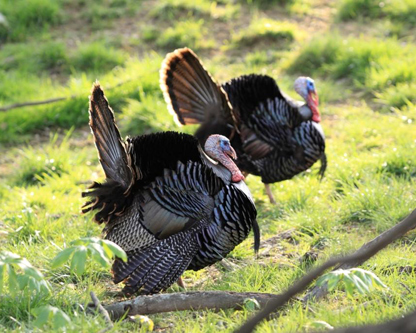BYKevin Kelly
FRANKFORT, Ky. – Hunters could have the long winter to thank for what is shaping up to be a good start to Kentucky’s statewide spring wild turkey season, which opens Saturday, April 12, and runs through May 4.
“The timing of the first peak in gobbling and our season opener should be pretty close this year because the long winter somewhat delayed the arrival of spring,” said Steven Dobey, wild turkey program coordinator for the Kentucky Department of Fish and Wildlife Resources.
Often the peak gobbling period falls before the season opener, affording gobblers time to breed hens before they could potentially fall prey to a hunter. The late break in the weather this year sets up an ideal scenario across much of the state with breeding activity – and the gobbling that goes with it – approaching a crescendo. The birds haven’t been disturbed and should be more responsive to a hunter’s call.

Last spring, Kentucky outpaced all surrounding states in the number of birds harvested per square mile. Hunters reported taking 32,498 wild turkeys for an average of 0.82 per square mile, placing Kentucky slightly ahead of neighboring Tennessee.
“We’re having this great success while doing so in a pretty narrow window of opportunity,” Dobey said. “It reflects the large geographic area in which we have turkeys. People can go to almost any area in the state and have good success in the spring.”
Approximately 90,000 people hunt wild turkeys in Kentucky and each is allowed a limit of two bearded birds during the spring season. Any combination of male turkeys, or female turkeys with visible beards, may be included in the season limit. No more than one bird may be taken per day.
Shooting hours are 30 minutes before sunrise to 30 minutes after sunset, but hunters can be in the field before or after shooting hours.
The Green River Region, encompassing 25 counties in the south-central part of the state, traditionally produces the highest harvest totals.
It accounted for 32 percent of all birds taken in 2013, with hunters in the Southeast Region coming in second with 24 percent of the annual spring harvest. This trend has continued this year as hunters in the Green River Region accounted for approximately 36 percent of birds taken during the spring youth-only hunting weekend that ended this past Sunday.
The region’s mix of forested land and agricultural fields makes it ideal for wild turkeys, Dobey said.
“When you incorporate the agricultural component, that jumps it up to another level because there’s a whole other source of food out there that isn’t as readily available to turkeys in some other regions,” he said.
Kentucky’s wild turkey flock numbered around 130,000 birds when restoration efforts ended in 1997 and the population is estimated to have grown to about 220,000 birds statewide.
Spring harvest totals have exceeded 32,000 birds each year since a record 36,097 were taken in 2010.
A spike in reproduction in 2008 is a driving factor behind the increased hunter success in recent seasons, but reproduction on the whole has been classified as moderate to poor for several years.
Kentucky Fish and Wildlife is participating in an ongoing research study looking into declines in wild turkey reproduction in the southeastern United States. The study’s findings will guide management efforts across the region.
“Most, if not all, southeastern states have observed declines in our summer brood surveys,” Dobey said. “It’s not unique to Kentucky. Rather, it’s a regional trend that all of us are curious about what could be causing this.”
An uptick in reproduction was observed last year in Kentucky. The average number of young turkeys (poults) per hen in 2013 was 1.9, up from 1.8 the year before.
Still, wildlife managers will be monitoring Kentucky’s spring turkey season closely after seeing a decline in the fall harvest. The 2013-14 fall season take of 2,671 turkeys represented a 39 percent drop over the previous fall harvest.
The fall turkey season can be somewhat tricky to analyze. Typically, about 70 percent of the birds are taken by shotgun and the shotgun season is comprised of two, seven-day periods that only include two weekends. Bad weather or even a major sporting event can keep hunters from going into the field.
“It’s something we’ll watch,” said Karen Waldrop, wildlife division director for Kentucky Fish and Wildlife. “It’s not alarming. The weather during that time was not ideal. But we will keep an eye on the spring harvest, which is probably a better indicator because low success during the fall season could be attributable to hunter participation. Nobody misses spring season.”
Hunters are encouraged to consult the 2014 Kentucky Spring Hunting Guide before heading into the field in search of a boss gobbler. It is available online at fw.ky.gov and includes information about current regulations, licenses and permits, legal equipment, safety tips and more.
Kevin Kelly is a staff writer for Kentucky Afield magazine, the official publication of the Kentucky Department of Fish and Wildlife Resources. He is an avid angler with a passion for muskellunge and stream fishing. Get the latest from Kevin and the entire Kentucky Afield staff by following them on Twitter: @kyafield.
-30-
The Kentucky Department of Fish and Wildlife Resources manages, regulates, enforces and promotes responsible use of all fish and wildlife species, their habitats, public wildlife areas and waterways for the benefit of those resources and for public enjoyment. Kentucky Fish and Wildlife is an agency of the Tourism, Arts and Heritage Cabinet. For more information on the department, visit our website at fw.ky.gov.


Be the first to comment